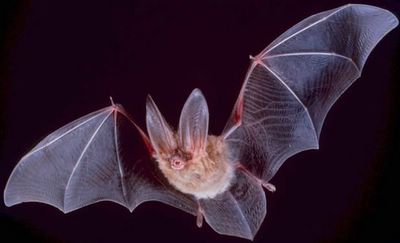
Big eared townsend fledermaus bat.

First stop Batworld . This site has many interesting facts about bats. We learn that bats are not blind and are actually mammals. Unfortunately, they are also an endangered species. Are bats useful? Quoting from the site..."Bats are vital to the ecosystem! Fruit bats bring us over 450 commercial products, including 80 medicines. The seed dispersal and pollination activities of fruit and nectar eating bats are vital to the survival of rain forests. Seeds dropped by tropical bats account for up to 95% of forest regrowth on cleared land. Night blooming plants and trees depend on nectar eating bats for pollination. An excellent example is the baobab tree of eastern Africa that is so important to the survival of other kinds of wildlife it is referred to as the "Tree of Life". "Bats in the US eat millions of tons of insects annually"”….. Even their droppings are useful. Bat or bird droppings or feces are called guano. Guano has been used for many years as fertilizer. Scientists are now able to extract enzymes from bacteria, which live only in guano, in order to make laundry detergents and other valuable products. Batworld tells us what to do if we find a bat either indoors or out, how to become a bat rehabilitator and help injured or orphan bats return to the wild and runs a wild sanctuary for bats in Mineral Texas. It is a non-profit organization working to save bats and educate one and all about this beautiful and gentle creature.
Bat Conservation International is a non-profit organization dedicated to the protection of bats and the restoration of bats and their habitat worldwide. This site is everything we want to know about bats and more. It has a bat trivia page as well as a bat FAQ. The species list allows us to identify bats that live in our area. There are beautiful pictures of bats throughout the site. There is an explanation of echolocation or biosonar - how bats see in the dark by emitting a high frequency sound or ultrasound. Here, we can read about rabies in bats and find out if we are in danger. Information is provided for joining the organization and help with their efforts to save the bats.
The site Vampire bats , aimed at kids, has pictures with fun facts. It seems that vampire bats don't drink human blood (they dislike it) but prefer blood from cows, pigs or sheep. There is an anticoagulant in the vampire's saliva which causes the blood to flow without clotting, allowing the bat to lick the blood rather then suck it. The anticoagulant from vampire bats' saliva has been synthesized and is now used in medication for human heart patients (bat saliva potential new treatment for stroke victims). But these bats can carry rabies that can be transmitted to humans.
How can we attract bats to our garden (what plants to grow) (or bats in the garden or gardening for bats)?
Bats for Kids is a great web site to learn about bats. This web site was created for kids with the hope that they…”will like, respect and help protect these endangered species"…. We learn where bats live; what they look like; how they help humans and what they eat-all written in kid friendly language.
A great interactive educational NASA site about bats is aimed at kids in grades 5-8. The site features the adventures of Echo the Bat. Echo learns to fly and becomes separated from his mother. The site challenges kids to use remote sensing (interpretation of satellite images) and biodiversity (a variety of living things in a habitat-a place where a plant or animal naturally or normally lives and grows) to locate Echo as he searches for his mother and other bats.
Lastly, an anecdote about a farmer and how he found out that bats were really his friends.
1 comment:
Glad you enjoyed the article exposedfifths. Hope you come back again :-)
Post a Comment